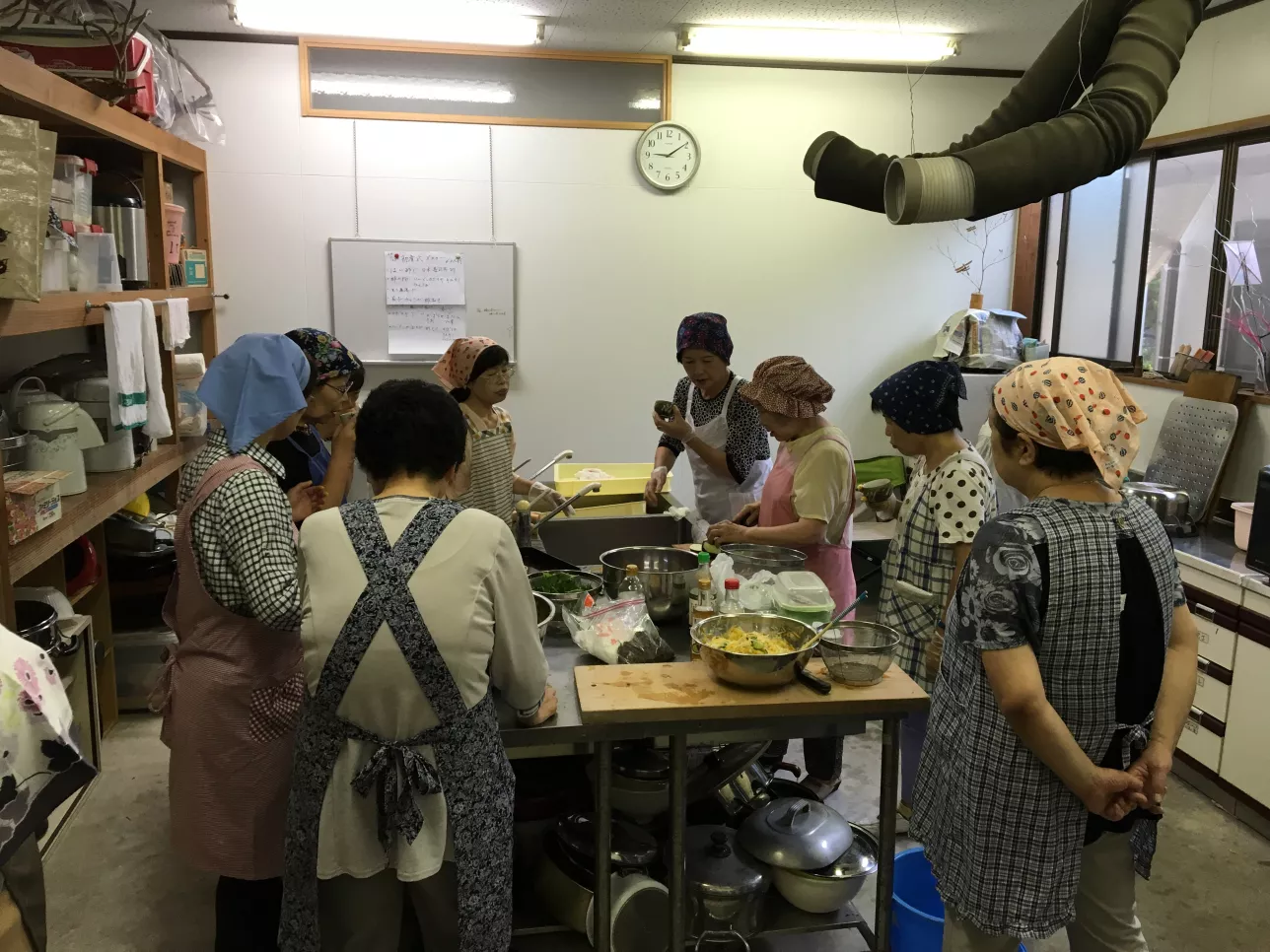Gendering Labor in Contemporary Asian Religions
Workshop 21-23 June 2022
“Gendering Labor in Contemporary Asian Religions” is a three-day closed workshop that aims to establish Asian religions as a robust and thriving area for the theoretical consideration of religion, gender, and labour.
It is a joint initiative of two Early Career Researchers in Japanese Religions: Gwendolyn Gillson (Assistant Professor of Asian Studies, Illinois College, US) and Paulina Kolata (Postdoctoral Fellow, Lund University, Sweden) who seek to build a network of scholars at all stages of their careers working on issues of gender, labour, and religion in contemporary Asia. By exploring labour at the intersection of religion and gender within contemporary Asian contexts, the workshop participants will investigate how worlds, individuals, collectives, and the things they produce are transformed through gendered and gendering realities. They will consider labour as processes and practices that construct religious worlds.
The workshop participants will consider: What is religious labour? How is it gendered and gendering? How does it look and feel? What does it produce, if anything? How is it valued and recognized?
Processes of gendering labour within religious contexts are entangled with everyday moraleconomies and realities moulded by local and global capitalistic networks. Gender ofteninfluences the ways labour is organized, valued, and experienced. It shapes the ways thatpeople see and understand the labour of themselves and others, encouraging alternative views for the processes of labour. Religious frameworks provide opportunities for revealing how places, institutions, and people’s practices shape the complex ways in which such labour is imagined and experienced.
We will investigate how worlds, individuals, collectives, and the things they produce aretransformed through gendered and gendering realities by exploring labour at the intersection of religion and gender within contemporary Asian contexts. The participants will consider labour as processes and practices that construct religious worlds. In doing so, the organizers seek to include voices from diverse religious and non-religious contexts where gendered religious labour takes place and that recognize the fluidity of gender identities.
15 participants have been invited to submit 2,000-word drafts of their papers ahead ofthe workshop. The deadline for paper drafts is May 16, 2022 and all participants will beexpected to read the submitted drafts before the workshop. During the workshop, participants will take turns at presenting brief overviews of their papers, with the bulk of the workshop given over to generous discussion involving other participants’ feedback and a moderated general discussion.
It is a closed workshop, but if you wish to participate, please email paulina [dot] kolata [at] ace [dot] lu [dot] se (paulina[dot]kolata[at]ace[dot]lu[dot]se)
Please explore the paper abstracts below for more information.
Religious labor among Sikhs in Italy: the gendering dimensions of seva
An important aspect of many South Asian religious traditions, seva (religious and social voluntary service) is commonly presented as a key feature of Sikh ethics and religious life. This religious labor takes many forms, including care for the weak, the elderly and non-human entities, distribution of free meal (langar) and congregational worship. It takes place in a variety of contexts both religious and secular, as well as transnational/diasporic ones.
The normative discourse widely shared in mainstream Sikhism affirms the same possibility by men and women to manifest devotion through any kind of seva, but empirical observation shows a different picture. Especially in the public space of gurdwaras, there is usually a clear division of tasks and religious labor that implicitly subtends a gender-based hierarchy. Different types of seva seem to affirm and consolidate a precise male and female identity and to have a gendering function. On the contrary, within the private space of the home women are more likely to perform guru seva, the religious voluntary service normally performed by men within collective spaces, along with other care tasks to religious objects.
The paper is based on data obtained through ethnographic observation, semi-structured interviews and focus groups in northern Italy between 2019 and 2021. The data were collected in 5 gurdwaras and in 10 Sikh homes, hosting religious objects and spaces and the research involved 23 Sikh women and men. We explore how young women born or raised in Italy may use the female participation in the religious seva within gurdwaras as the tool for change of power relations that cross genders and generations, trying to distinguishing between the religious message and Punjabi cultural customs and traditions. Furthermore, we explore the affective, intimate meaning and emotional involvement of the guru seva which, in the case of women, finds expression mainly in the home environment.
Gender Balance in the Production of Paper-Offerings
This research is based on an ethnographical study of the production, consumption, and household economy of paper-offerings, which are ‘traditional’ folk handicrafts used in funerary ceremonies and religious rituals staged for gods, ancestors, and ghosts in Han Chinese society since the Song Dynasty. The producers of paper-offerings are regarded as craftsmen and “household religious specialists” (Chau 2006; 2010) and play a key role to support the religious life in the local society. Gender relationships of the members of the paper-offering producers’ households play a pivotal role in the task division and cooperation. The modes of division and collaboration are based on conjugal relations, which possess dynamic characteristics of balance and cooperation. Collective operation in the practical production of paper-offerings is dictated by the interest of the households, rather than simply based on “separating the sexes” (Ebrey 1993: 21) or “sexual division” (Jacka 1997: 1) of patriarchal logic, such as the distinction between “inside” and “outside” as well as the distinction between “heavy” (zhong 重) and “light” (qing 轻) work (also see Jacka 1997). The focus of the research is to analyse the role played by conjugal relations in coordinating and balancing the division and cooperation among the household members or the religious labourers in the production of paper-offerings.
The Laborious Non-Self: Women’s Religious Labor in Rural Qinghai
There is an a priori assumption amongst Buddhist practitioners that to understand the self as anything other than a misperception of reality is a mistaken view, but does this also imply that Buddhist women lack agency? The foundational Buddhist principle of no-self (bdag med), according to Tibetan lay practitioners in contemporary Qinghai, does not forestall the ability of Buddhist women to exert agency. I push beyond a post-structuralist critique of reading desire (Chow 2002) or resistance (Mahmood 2011) on to the lives and experiences of religious women, suggesting that agency can exist outside the neoliberal self. This paper uses ethnographic data on women’s religious labor in a Drikung Kagyu monastery in Qinghai to think through agency as something other than an exertion of self. Working alongside Tibetan women from 2017-2020, I sought to understand why women invest so much labor into their religious lives. As opposed to seeing women’s dedication to the monastery and their religious practice as something that could bring about social capital or solidify ego-driven status, women discussed motivation (kun spyod) and the positive effects of effort (‘bad brtson) as essential catalysts for realization. Women framed their agential activities as acts of labor that would transform them as much, if not more than, material reality would be transformed by their labor. The kinds of religious labor women perform simultaneously produce fundamental change in the object and agent of labor. This is confluent with the Buddhist principle that transformation is both inevitable (as all phenomena are impermanent) and necessary for realization (as the unenlightened mind is obscured). In this model, neither labor nor transformation are reliant upon a free-willed, independent and permanent self. In fact, the act of labor forestalls the ability to theorize a permanent female agent. She is changing in the very act of her laboring. Based upon formal interviews, oral histories and participant-observation, I suggest a new model for thinking about the relationship between women’s religious labor and agency in a Buddhist context.
Parenting as Religious Labor in Taiwanese Picture Books
Picture books are some of the first places young children learn about work and labor, both inside and outside of the home. Stories introduce children to community workers like teachers, firefighters, and doctors; they also show domestic life, and family members engaged in cooking, cleaning, and other homekeeping tasks. This paper proposes that picture books published by Buddhist presses in Taiwan introduce children to forms of religious labor, and how that labor is gendered. Looking at publications from Tzu Chi 慈濟and Xiangguang 香光—two prominent Buddhist organizations in Taiwan, both led by women—I will argue that religious education of children is depicted as a part of parenting that falls to mothers and other female relatives. This religious labor is represented alongside tasks such as preparing meals and caring for children. Further, religious education in this picture books is understood to be part of social-emotional development, meaning that some forms of affective labor in the family are also religious in nature. Moving outside the stories and illustrations, the production and consumption of picture books is also gendered religious labor. Not only are many of the authors and illustrators women, but mothers are more likely to purchase and read picture books to their children: the paratexts in the books reflects the idea of mother as a teacher and guide, as do accounts of reading groups centered on these books. Attending the gendered labor of parenting, which largely takes place outside institutions and in intimate spaces removed from the public eye, allows us to expend our account of religious labor in Buddhism.
The Religious Labor of Reconciliation: Nuns, Laywomen and Buddhism in Europe’s “Little Hanois” and “Little Saigons”
Is “religious labor” in Vietnamese Buddhism primarily volunteering to support the pagoda through cooking, preparing offerings and participating in festivals, or does it also include the intellectual labor of healing the divisions sown by a civil war? Vietnamese communities in Europe are divided into “Little Hanois” and “Little Saigons”, with most in Eastern Europe (Prague, East Berlin, Moscow) led by former contract laborers from the north, and most in Western Europe (Paris, West Berlin) led by former refugees from the south. Scholars described Buddhism in Vietnam as as a practice where women volunteer as cooks, charity workers and worshippers, but men dominate in leadership, administration and doctrine. But in 21st century post-socialist Europe the growth of Vietnamese Buddhism has seen a transformation of gender roles within lay and clerical organizations. Nuns lead some of the most influential pagodas, notably Linh Thứ’u in Spandau, near Berlin, where they serve a mixed population of former workers and refugees by forbidding the flying of national flags. Bringing together communities that for decades have held separate New Year celebrations, autumn moon festivals and commemorations for ghosts and the war dead, they refashioned religious labor as a project of reconciliation. Stressing Buddhist values of compassion and shared suffering, they celebrate Buddha’s birthday with a congregation of former political enemies. Doctrinal differences between southern intellectual traditions and popular northern connections to goddess worship and material wellbeing need to be reconciled, as well as the social goals of easing the burdens of migrants, reinforcing ties to the homeland, and providing a sense of inner peace to families once divided by war. This “labor of reconciliation” is led by women, especially nuns, drawing on cultural ideas that women are gentle, nurturant and loving, while men are more attached to political differences.
Dharmic Cooking, Tasting Dharma: An Autoethnography of Culinary Training with Thai Nuns
Division of labor in Thai Buddhist monasteries is common to observe nuns and laywomen involved with preparing food for the entire monastic community (Sangha) while monks and laymen engage with construction and ritualistic responsibility. This allows scholars to conclude that this is symptomatic of inequality inherent in the patriarchal Sangha community--assigning sacred and substantial tasks to men and ‘housework’ to women--replicating the typical Asian family model of keeping women as a housewife taking care of babies, house and kitchen. This paper aims to challenge this misconception by showing how kitchen work in Sangha communities in Thailand are operated and perceived as a central part of dharma practice. Based on an autoethnography of experience in intensive culinary training from nuns in several meditation monasteries in Thailand from 2012-2020, I argue that cooking is not simply an undesirable duty assigned for the common, unskilled members of a sangha community. Instead, cooking involves an advanced dharma practice so the ‘well-trained chef’ will be able to come out with gourmet tasting perfect for the entire Sangha community. Reflecting on the life trajectories of these high-skilled culinary labors in the Thai monasteries, reminiscing my training experience and its aftereffects together with pondering on the stories of cooking labors in Buddhism, this paper further demonstrates how the division of labor, gender and dharma are intricately interwoven.
The Labor of Devotion in Contemporary Myanmar
“Devotion” is a nebulous concept in studies of contemporary Theravada Buddhist traditions, where it is commonly employed by scholars as a catchall reference for practices rejected by Buddhist reformists and modernists as not truly Buddhist. In contrast, this paper pursues an understanding of devotion as a core form of reproductive labor in the maintenance and transmission of the Buddha-sāsana. This exploration draws inspiration from my ethnographic research among Myanmar thilashin (initiated 8-precept nuns) and from the varied writings of dissident writer Ludu Daw Amar, an outspoken leftist and feminist in Myanmar at a time when it was safe to be neither. For example, her 1987 essay “An unlisted occupation” critiques the nonrecognition of Myanmar women’s reproductive labor and argues for the collective social responsibility of care for children and elders. In addition to her political writings, Ludu Daw Amar also wrote extensively of her personal relationships with Buddhist figures such as the thilashin Sayagyi Daw Dhammacari, about whom she wrote a biography (published in 1980) that lauds the Sayagyi’s service to the Buddha-sāsana. Honing in on Ludu Daw Amar’s vocabularies of labor and devotion drawn from both Buddhist and secular sources, I apprehend devotion as a form of personal responsibility for a collective future, whether of the sāsana, the nation, or other frames of shared future, asking how the labors of devotion are gendered for female Buddhist devotees (both lay and initiated) in contemporary Myanmar.
Purified Ground, Polluted Bodies: Gender and Labor in the Shinto Ground Purification Ceremony
This paper uses ethnographic fieldwork and interviews to examine the ground purification ceremony (jichinsai), a ritual performed by a Shinto priest before construction begins at a site, as a window into how female Shinto priests navigate gender. Female priests often justify their presence within their family shrine as an extension of their duties as wives and daughters, and they may even be lauded for performing “family-related” rituals for parishioners. However, female priests consistently identify the ground purification ceremony as one of the hardest rituals to perform. The ground purification ceremony must be performed outside of their home/shrine (and thus takes place in an inappropriate arena for women’s activity) and requires interfacing with the male-dominated construction industry, which is more likely to espouse traditional beliefs about menstrual and childbirth pollution rendering women unsuitable as ritualists. By examining how female priests navigate ground purification ceremonies, we can see that while the priest’s role is always both social and embodied, the strategies that female priests adopt to tackle the ground purification ceremony are influenced by the specific conditions of their shrine as much as their gender. Female priests at shrines with a larger (gender-diverse) staff or a less precarious financial base can opt to send another priest in their place or decline to perform the ceremony, but female priests at smaller, less well-staffed shrines must find means to enhance their perceived authority, such as wearing “male” vestments and hiding physical conditions (such as pregnancy) that may be perceived as especially “polluting.”
Labouring for harmony: Ethnographic insights into self-making practices among young Hindu women in Bali
This project explores the construction of self among young Hindu women in the North of Bali, based on longterm ethnographic research. Some of the “requirements” for be(com)ing an “appropriate”, “strong” Balinese woman refer to being a good Hindu, knowing how to prepare Balinese ceremonies and offerings, and manage her own emotions in a way that does not lead to public display of “negative” emotions such as worries, sadness, or anger. These traits are entangled in gendered religious and emotional labor, which include taking care of other people’s emotions (and needs), within the larger social networks of the young women. Women's labor includes the ability (and duty) to maintain harmonious social interactions within the extended family, helping during the frequent Balinese ceremonies, cook and handcraft the offerings, and engage in small talk with everyone present. Meeting often for ceremonies and activities with family members, neighbours, and other community members, implies a physical closeness that can sometimes turn into social envy and prying. This makes it harder for women to both display only "positive" emotions, and maintain harmonious social interactions. I argue that in a patriarchal context, the emotional labor these women perform (especially during religious events), can generate techniques allowing them to navigate and contest the local hierarchies and prescribed definitions of womanhood.
The Making of the Karyakarta: Exploring the Construction of Hindu Nationalism as Gendered Religious Work
My proposed paper (which is part of my larger PhD project and builds on my MPhil research) seeks to explore Hindu nation- making in the contemporary political moment by tracing the relationship of ‘nation’ as a symbolic, material and affective category with gendered activism, labor and work. Through interviews with ‘activists’ associated with a militant Hindu nationalist organization, I examine the making of Hindu nationalist activist subjectivities of the karyakarta or ‘activist’ as they are shaped through the spaces of work and activism they are embedded in with a focus on their gendered and caste-marked ‘spiritual genealogies’. The karyakarta, translated literally as the ‘doer of work’, in whose practice, karya or work becomes one with ‘activism’ and is articulated as seva or charitable service (Srivatsan 2014) is a generative figure to think through the historical construction of Hindu nationalism as religious work. Srivatsan, in his genealogical tracking of seva, has demonstrated the ways in which seva as a “non-cognitive moral category” has been made use of by various kinds of socio-political forces for a variety of intersecting purposes, with its roots in Christian religious discourse and notable mobilization in Gandhian politics in early 20th century India (Srivatsan 2014: 11). I hope to show through this paper that the persistence of the seva-nationalism-gender triad is located in the politics of what gets named and produced as religious work, a question anchored in gender and caste politics of contemporary Northern India.
Labor or not? Religious Performances as Service for the Gods in Taiwan
To many of my interlocutors in Taiwan, the proposition that religious activity might constitute labor would seem preposterous. And yet, this is exactly the conundrum that participants at traditional religious events are facing. Most of the work at religious festivals is done by performance troupes who provide leisure for crowds of spectators. Due to high demand and competition from other groups, many such troupes have turned professional. Though contested and concealed, some form of compensation has become commonplace. Reflecting liberalizing trends in Taiwanese popular religion and growing gender equality in society, this has affected previous gender-based divisions of labor. Women have generally become more visible as performers, for example in all-women’s teams of sedan chair bearers, one of the roles traditionally denied to them.
Looking for entertainment, most spectators are not bothered by these trends, and changing gender roles are less of a problem for traditionally minded participants than pay-for performances. To them, religious performance ought to be a “service for the gods” (gei shenming fuwu), a proposition contradicted by accepting financial compensation for one’s services. Even though this work may be labelled “affective labor”—based on its tendency to create sociality and “cultural intimacy” (Herzfeld 2016) between people—the traditionally grounded model of religion-as-service resists such classification. Indeed, recognizing performances as labor would diminish their spiritual value—which is why remuneration often takes the form of a gift (money in a red envelope). This raises the question of labor as analytical or ideological category, itself extending a neoliberal logic.
“Local Transmission of Salafism: Gendered Division of Labor among the Contemporary Hui
Salafism has been present among the Hui Muslims in mainland China for a century. Its transmission in the early 20th century is fragmentary, depending mainly on individual efforts through a trickle of translation and publication. Against the backdrop of China’s reform and opening-up policies since the late 1970s, the network to disseminate Salafi doctrines among the Hui is gradually taking its shape. In this process, women are not merely passive receivers or active seekers of Islamic knowledge. Rather, they assume a pioneering and leading role in the construction and maintenance of the key nodes of this network, such as Salafi-aligned Muslim school that this paper addresses. To be specific, this paper examines gendered division of labor in operating school under the conceptual framework of “place.” The discussion focuses on the sense making of school as place and the continual making of place. It follows two lines of enquiry. First, what does school as a place mean to the male and female Hui respectively? And in what way the sense making is related to their valuing labor as practice and expression of piety beyond the sphere of ritual performance? Second, how do the social and cultural capitals they possesses respectively enable both to work together, and equally important, to compromise to each other? And what does this imply to daily teaching and administrative activities within school?
The event is jointly sponsored by the Centre for East and South-East Asian Studies and the American Academy of Religion through the AAR International Collaborative Research Grant.
Workshop
Date: 21-23 June 2022
Venue: The Centre for East and South-East Asian Studies, Lund University
Contact for more information: paulina [dot] kolata [at] ace [dot] lu [dot] se (Paulina Kolata)





